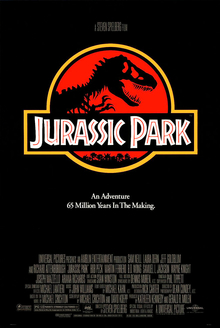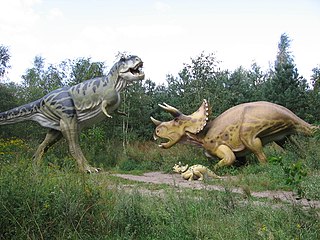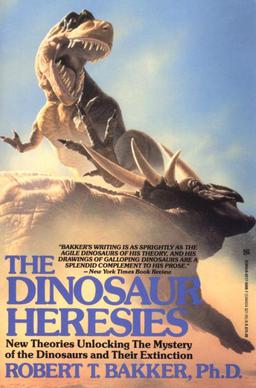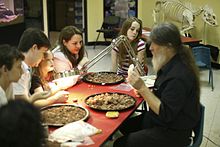
Dinosaurs are a diverse group of reptiles of the clade Dinosauria. They first appeared during the Triassic period, between 243 and 233.23 million years ago (mya), although the exact origin and timing of the evolution of dinosaurs is a subject of active research. They became the dominant terrestrial vertebrates after the Triassic–Jurassic extinction event 201.3 mya and their dominance continued throughout the Jurassic and Cretaceous periods. The fossil record shows that birds are feathered dinosaurs, having evolved from earlier theropods during the Late Jurassic epoch, and are the only dinosaur lineage known to have survived the Cretaceous–Paleogene extinction event approximately 66 mya. Dinosaurs can therefore be divided into avian dinosaurs—birds—and the extinct non-avian dinosaurs, which are all dinosaurs other than birds.

Tyrannosaurus is a genus of large theropod dinosaur. The type species Tyrannosaurus rex, often shortened to T. rex or colloquially T-Rex, is one of the best represented theropods. It lived throughout what is now western North America, on what was then an island continent known as Laramidia. Tyrannosaurus had a much wider range than other tyrannosaurids. Fossils are found in a variety of rock formations dating to the latest Campanian-Maastrichtian ages of the Late Cretaceous period, 72.7 to 66 million years ago. It was the last known member of the tyrannosaurids and among the last non-avian dinosaurs to exist before the Cretaceous–Paleogene extinction event.

Velociraptor is a genus of small dromaeosaurid dinosaurs that lived in Asia during the Late Cretaceous epoch, about 75 million to 71 million years ago. Two species are currently recognized, although others have been assigned in the past. The type species is V. mongoliensis, named and described in 1924. Fossils of this species have been discovered in the Djadochta Formation, Mongolia. A second species, V. osmolskae, was named in 2008 for skull material from the Bayan Mandahu Formation, China.

Jurassic Park is a 1993 American science fiction action film directed by Steven Spielberg, produced by Kathleen Kennedy and Gerald R. Molen, and starring Sam Neill, Laura Dern, Jeff Goldblum, and Richard Attenborough. It is the first installment in the Jurassic Park franchise, and the first film in the original Jurassic Park trilogy, and is based on Michael Crichton's 1990 novel of the same name, with a screenplay by Crichton and David Koepp. The film is set on the fictional island of Isla Nublar, off Central America's Pacific Coast near Costa Rica, where a wealthy businessman John Hammond (Attenborough), and a team of genetic scientists have created a wildlife park of de-extinct dinosaurs. When industrial sabotage leads to a catastrophic shutdown of the park's power facilities and security precautions, a small group of visitors, including Hammond's grandchildren, struggle to survive and escape the now perilous island.

John Robert Horner is an American paleontologist most famous for describing Maiasaura, providing the first clear evidence that some dinosaurs cared for their young. In addition to his paleontological discoveries, Horner served as the technical advisor for the first five Jurassic Park films, had a cameo appearance in Jurassic World, and served as a partial inspiration for one of the lead characters of the franchise, Dr. Alan Grant. Horner studied at the University of Montana, although he did not complete his degree due to undiagnosed dyslexia, and was awarded a Doctorate in Science honoris causa. He retired from Montana State University on July 1, 2016, although he claims to have been pushed out of the Museum of the Rockies after having married an undergraduate student and now teaches as a Presidential Fellow at Chapman University.

Raptor Red is a 1995 American novel by paleontologist Robert T. Bakker. The book is a third-person account of dinosaurs during the Cretaceous Period, told from the point of view of Raptor Red, a female Utahraptor. Raptor Red features many of Bakker's theories regarding dinosaurs' social habits, intelligence, and the world in which they lived.

Gregory Scott Paul is an American freelance researcher, author and illustrator who works in paleontology. He is best known for his work and research on theropod dinosaurs and his detailed illustrations, both live and skeletal. Professionally investigating and restoring dinosaurs for three decades, Paul received an on-screen credit as dinosaur specialist on Jurassic Park and Discovery Channel's When Dinosaurs Roamed America and Dinosaur Planet. He is the author and illustrator of Predatory Dinosaurs of the World (1988), The Complete Illustrated Guide to Dinosaur Skeletons (1996), Dinosaurs of the Air (2001), three editions of The Princeton Field Guide to Dinosaurs, Gregory S. Paul's Dinosaur Coffee Table Book (2010), The Princeton Field Guide to Pterosaurs (2022), The Princeton Field Guide to Mesozoic Sea Reptiles (2022) and editor of The Scientific American Book of Dinosaurs (2000).

John Harold Ostrom was an American paleontologist who revolutionized the modern understanding of dinosaurs. Ostrom's work inspired what his pupil Robert T. Bakker has termed a "dinosaur renaissance".

Tyrannosaurus rex is unique among dinosaurs in its place in modern culture; paleontologist Robert Bakker has called it "the most popular dinosaur among people of all ages, all cultures, and all nationalities". Paleontologists Mark Norell and Lowell Dingus have likewise called it "the most famous dinosaur of all times." Paleoartist Gregory S. Paul has called it "the theropod. [...] This is the public's favorite dinosaur [...] Even the formations it is found in have fantastic names like Hell Creek and Lance." Other paleontologists agree with that and note that whenever a museum erects a new skeleton or bring in an animatronic model, visitor numbers go up. "Jurassic Park and King Kong would not have been the same without it." In the public mind, T. rex sets the standard of what a dinosaur should be. Science writer Riley Black similarly states, "In all of prehistory, there is no animal that commands our attention quite like Tyrannosaurus rex, the king of the tyrant lizards. Since the time this dinosaur was officially named in 1905, the enormous carnivore has stood as the ultimate dinosaur."

Jurassic Park is a 1990 science fiction novel written by Michael Crichton. A cautionary tale about genetic engineering, it presents the collapse of a zoological park showcasing genetically recreated dinosaurs to illustrate the mathematical concept of chaos theory and its real-world implications. A sequel titled The Lost World, also written by Crichton, was published in 1995. In 1997, both novels were republished as a single book titled Michael Crichton's Jurassic World.
The physiology of dinosaurs has historically been a controversial subject, particularly their thermoregulation. Recently, many new lines of evidence have been brought to bear on dinosaur physiology generally, including not only metabolic systems and thermoregulation, but on respiratory and cardiovascular systems as well.

Cultural depictions of dinosaurs have been numerous since the word dinosaur was coined in 1842. The non-avian dinosaurs featured in books, films, television programs, artwork, and other media have been used for both education and entertainment. The depictions range from the realistic, as in the television documentaries from the 1990s into the first decades of the 21st century, to the fantastic, as in the monster movies of the 1950s and 1960s.

The dinosaur renaissance was a highly specified scientific revolution that began in the late 1960s and led to renewed academic and popular interest in dinosaurs. It was initially spurred on by research indicating that dinosaurs may have been active warm-blooded animals, rather than sluggish cold-blooded lizard-like reptilians as had been the prevailing view and description during the first half of the twentieth century.

The Dinosaur Heresies: New Theories Unlocking the Mystery of the Dinosaurs and Their Extinction is a 1986 book written by Robert T. Bakker.
Phylogenetic bracketing is a method of inference used in biological sciences. It is used to infer the likelihood of unknown traits in organisms based on their position in a phylogenetic tree. One of the main applications of phylogenetic bracketing is on extinct organisms, known only from fossils, going all the way back to the last universal common ancestor (LUCA). The method is often used for understanding traits that do not fossilize well, such as soft tissue anatomy, physiology and behaviour. By considering the closest and second-closest well-known organisms, traits can be asserted with a fair degree of certainty, though the method is extremely sensitive to problems from convergent evolution.

Jurassic Park is a 1993 video game developed by BlueSky Software and published by Sega for the Sega Mega Drive/Genesis. It was released as part of the tie-in merchandise to the 1993 film of the same name. The game includes elements from Michael Crichton's 1990 novel, Jurassic Park, on which the film is based.

Paleoart is any original artistic work that attempts to depict prehistoric life according to scientific evidence. Works of paleoart may be representations of fossil remains or imagined depictions of the living creatures and their ecosystems. While paleoart is typically defined as being scientifically informed, it is often the basis of depictions of prehistoric animals in popular culture, which in turn influences public perception of and fuels interest in these animals. The word paleoart is also used in an informal sense, as a name for prehistoric art, most often cave paintings.

Paleontology in the United States refers to paleontological research occurring within or conducted by people from the United States. Paleontologists have found that at the start of the Paleozoic era, what is now "North" America was actually in the southern hemisphere. Marine life flourished in the country's many seas. Later the seas were largely replaced by swamps, home to amphibians and early reptiles. When the continents had assembled into Pangaea drier conditions prevailed. The evolutionary precursors to mammals dominated the country until a mass extinction event ended their reign.

Jurassic Park, later also referred to as Jurassic World, is an American science fiction adventure media franchise. It focuses on the cloning of dinosaurs through ancient DNA, extracted from mosquitoes that have been fossilized in amber. The franchise explores the ethics of cloning and genetic engineering, and the morals behind de-extinction.

Velociraptor was popularized by its appearance in the Jurassic Park franchise, which features numerous individuals. They first appear in Michael Crichton's 1990 novel Jurassic Park, followed by a 1993 film adaptation from director Steven Spielberg, which spawned a series of films. Despite their name, Crichton heavily based the Velociraptors on the larger Deinonychus, and this was carried over into the films. The on-screen raptors were created using several production methods, including animatronics by Stan Winston and CGI by Industrial Light & Magic (ILM).




















